7 reasons to fall in love with Martinique
As I’d never been to the Caribbean before, I immediately said yes when my friend Marie suggested we go to Martinique. This was not meant to be a relaxing holiday; instead, we would spend a week practicing sports of our choice. I opted for a combination of mostly water sports and activities, such as kayaking, catamaran, sailing, hiking, horse riding and windsurfing, whereas Marie chose to practice the latter for our entire week there.
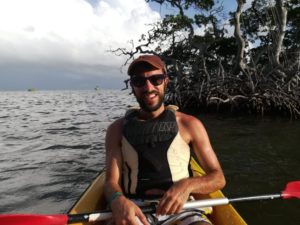
Located in the Lesser Antilles of the West Indies in the eastern Caribbean Sea, Martinique is a single island directly north of Saint Lucia, and south of Dominica. Having a similar size to the Greek island of Rhodes, it is considerably smaller than Corsica and the biggest islands of the Mediterranean. It is one of the five overseas departments and regions of France (the other four being Guadeloupe, also in the Caribbean, French Guiana in South America, and Réunion and Mayotte in the Indian Ocean). Yet, little reminds of Metropolitan France (la Métropole). The almost 400,000 inhabitants may speak French but the majority are of African descent.
I’m not sure how exactly I’d imagined Martinique, perhaps something between a French city in the tropics, and a more exotic version of the Greek islands. It was neither. As I’m yet to visit any of the other islands of the Caribbean, I cannot comment on how typical of the region it is; however, I have the gut feeling that it is a rather typical Caribbean island. Of course, there is only one way to check this out.
7 reasons to fall in love with Martinique
On reflection, I think that Martinique’s charm lies in its simplicity and authenticity. Forget about fancy cocktail bars, luxurious hotels, and pretentious clubs. Also, forget about Ryanair, Easyjet and anything low-cost. Even though Martinique is a popular holiday destination for the French, it seems rather unaffected by cheap and mass tourism escaping the colder climates of Northern Europe; unlike most Mediterranean islands, here you’re unlikely to come across chavs on all-inclusive holidays.
For me, Martinique has been a great introduction to the West Indies. Part of me wants to share my experience with the world; most of my friends hadn’t even heard of Martinique until I told them I’d be going there. At the same time, another part of me fears that spreading the word will change the island’s touristscape and character. I hope it doesn’t.
1. La cuisine creole
Until I visited Martinique, I’d thought of Caribbean cuisine as little more than charred jerk chicken. Having only tried Jamaican street food in Britain, I assumed that it was representative of the region’s rich culinary tradition. Unsurprisingly, I was wrong. Even though the food was not the prettiest or the most instagrammable, the flavors were so bold and beautiful that I was instantly converted. ‘Boudin’ (a type of sausage similar to the British black pudding), ‘chatrou’ (a small octopus that can be cooked in different ways) and ‘lambis’ (a sea snail also cooked in a variety of ways) are amongst the most typical Martinican foods.
The Yellow
I had my first taste of Martinican cuisine at the ‘Yellow’. Situated on the first floor on a backstreet of Fort-de-France, the island’s capital, it is one of those hidden gems that you’re unlikely to discover, unless recommended by someone with inside knowledge. I’m glad this was the case. Despite the restaurant’s name, red color dominated the décor creating an atmosphere that I would later come to associate with Martinique. The menu had clear influences from both local and French cuisine. There were about ten items, equally divided between starters, mains and desserts. I was hoping to taste the urchin risotto; however, as it wasn’t available on that day, I had ‘accras de morue’ (salt cod fritters served as an appetizer) followed by beautifully cooked turbot. The cocktail menu was not short of choice; I opted for a ‘Yellow’ (rum, Malibu, pineapple juice, crème de cassis and champagne).
Chez Malou
Another great choice was ‘Chez Malou’, a traditional restaurant on the mountainous road to Morne Rouge, about 30 km north of Fort-de-France. Even though the menu options were limited, this did not bother me the least. I was hoping to have shark soup, but again it wasn’t available on that day. Instead, I had chicken ‘colombo’, a signature Martinican dish, while my friend opted for chicken fricassée.
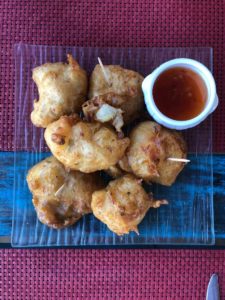
2. Les fruits exotiques
Exotic fruits, such as guavas, papayas, mangos, pineapples, bananas and coconuts are ubiquitous on the island. You can buy them fresh in the markets, as well as in jams, desserts, juices, cocktails, sorbets or ice creams. There’s even a banana museum (la Musee de la Banane), which can be found in a working plantation near the northeast town of Saint Marie. Other exotic (but not as sweet) fruits you can find in Martinique include the prune de cythère and the carambole, also known as star fruit.
However, make sure you stay clear of manchineel, otherwise known as beach apple or little apple of Death. This fruit may look like a small apple, but it can be fatal when eaten. The manchineel tree, which can be found on coastal beaches, is one of the most dangerous trees in the world. Even standing beneath the tree is considered unsafe; a small drop of rain mixed with the milky substance produced by the tree may cause the skin to blister when it comes in contact with it. Fortunately, most trees are marked to warn locals and visitors of their potentially fatal effects.
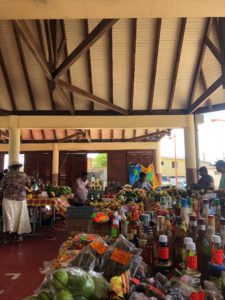
3. Les desserts
It is no secret I have a sweet tooth. With so many delicious desserts to choose from, I could hardly resist the temptation (and why should I?).
I had my first taste in Fort-de-France, which I visited on a Sunday morning. There were a few stalls outside the ‘Cathédrale Saint-Louis’ in the town center. Local vendors were selling a variety of sweet and savoury bakes, some of which were made with the aforementioned exotic fruits.
I had my favorite desserts at ‘Rose Bleue’ at Pointe Faula in Vauclin. These included the famous ‘mal élevé’ (made with sweet potato and coconut) and ‘l’amour caché’ (made with banana and guava jam). Their sorbets were also excellent; I had a delicious coconut and guava sorbet.
Sorbets are also sold by local vendors on the beach; they often ring a bell to attract the beach-goers’ attention. Sometimes, I wonder why I came back to rainy London.
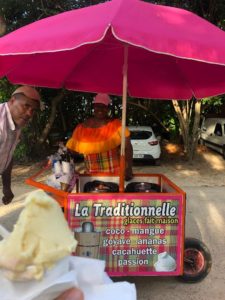
4. Le rhum et les cocktails exotiques
Martinique is full of rum distilleries; the Habitation Clément, located near the town of Francois, is the most famous. Rhum Agricole is a locally-produced type of rum that is made directly from fresh free-run sugarcane juice, unlike the traditional rum which is made from molasses.
Piña colada, mojito and daiquiri may be the most famous rum-based cocktails and have close ties to the islands of the Caribbean, yet they are not typical of Martinique; piña colada and mojito originate from Puerto Rico and Cuba respectively, whereas the inspiration for the daiquiri can also be traced to Cuba. Traditional Martinican cocktails include the ‘ti’punch’ (rum, sugar or syrup, and lime), the ‘punch coco’ (rum, coconut milk, sugar or syrup, and spices) and the ‘planteur’ (rum, sugar or syrup, and juice of different fruits, including orange and pineapple); you will come across them anywhere on the island. I enjoyed a number of those at the beachside restaurant ‘Chez Marie-Alice’ in Vauclin. Some of these cocktails are also available in bottles sold in the traditional markets all around the island.
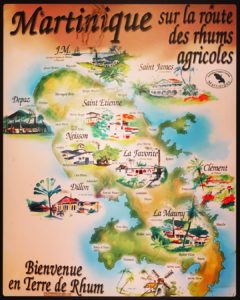
5. La musique
Jamaican musicians are worldwide famous: Bob Marley, Shaggy and Sean Paul to name a just a few. Rihanna was born and bred in Barbados, whereas Nicki Minaj is from Trinidad.
How about the Martiniquais? Well, none of the island’s musicians has made it that big, but this is not to say that music is not an integral part of the island life. Just wander in the streets of Ford-de-France, or go to a beach; you will undoubtedly see and hear the locals’ partying (even on the boats). Or, simply turn on the radio; FUN Radio will instantly put you in the mood for dancing to the Caribbean rhythms. Zouk, in particular, is a musical style originating from Martinique and Guadeloupe; it became popular in metropolitan France in the late 20th century. Needless to say that the locals are excellent dancers.
If you prefer jazz instead, make sure you visit Martinique in August, when the Festival Biguine Jazz takes place.
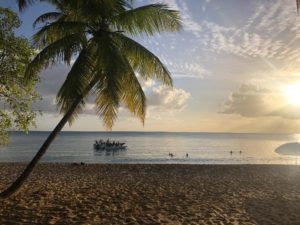
6. La mer et les sports nautiques
It’d be a shame to go to Martinique and not go to the beach. The ones on the west and south coasts of the island (the Caribbean coasts) are best for swimming and sunbathing, whereas the ones on the Atlantic (east) coast are best for water sports and activities such as surfing, windsurfing, kite-surfing and catamaran. Other water sports and activities available include diving, snorkelling, kayaking and of course sailing.
From Fort-de-France to Diamand
The most popular beaches are those of the Trois-Îlets and the Anses-d’Arlet; they are located on the southwest coast of the island not far from Fort-de-France. The Anse-à-l’Ane is a beautiful palm-lined beach, albeit not the most famous. On the contrary, the Anse Dufour and the neighbouring Anse Noire, are among the most popular, but also quite easy to miss if you drive there. Moreover, the road to the beach is very narrow; be prepared to manoeuvre your car to make way for cars coming on the opposite direction. Continue along the road to Diamand: the Grande Anse, the Plage du Bourg and the Petite Anse are also worth visiting. The ‘Ti Sable’ beach bar/restaurant on the Grande Anse is a good choice for food and drinks. At the village Anse d’Arlet Bourg, there’s a market selling fresh fruit, bottled cocktails and spices.
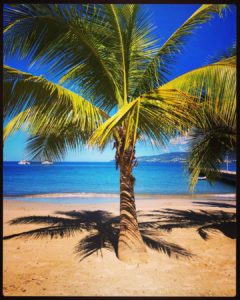
From Diamand to Vauclin
Continue east along the island’s south coast; the Plage du Diamant is famous for the water sports and activities. Further east, there’s the Plage de la Pointe Marin, a perfect place to enjoy a cocktail and watch the sunset. I loved the small bar with tables in the sea. From there, continue to the palm-lined Grande Anse des Salines, the island’s most famous beach. Like most of the beaches in Martinique, it is not an organized one. Watch out for the local vendors selling sorbets, often ringing a bell to attract the beach-goers’ attention. The nearby Petite Anse des Salines is nudism-friendly and popular with the LGBT visitors. Continue towards Vauclin on the Atlantic coast. Here you can find another market selling fresh fruit, bottled cocktails and spices, and also the ‘Club Nautique du Vauclin’, at Pointe Faula, where you can take part in water sports and activities.
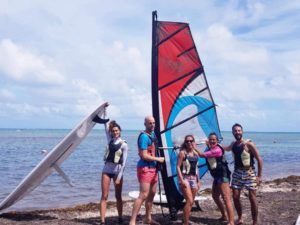
North of Fort-de-France
I’ve earlier mentioned that I’d imagined Martinique to be quite different to how it was; I was actually taken aback by the fact that the beaches were nowhere near as organised as the ones on the Greek islands. Beach bars were scarce; the few ones I came across, like the ‘Ti Sable’ on the beach of Grande Anse, served traditional food and drinks, but lacked the party vibes I’d expected. ‘Shell’s’ in Case Pilote, north of Fort-de-France, was the only beach bar that resembled the ones in my home country; I enjoyed a couple of exotic cocktails while watching the sun setting over the Caribbean Sea.
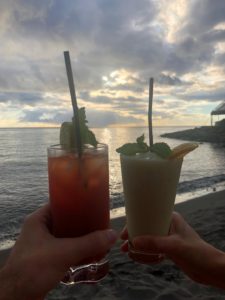
7. La nature
A volcanic island, Martinique boasts beautiful mountainous landscapes and offers a number of hiking trails, especially on the north of the island. Horse riding is another popular activity; there are several places including one at Macabou near Vauclin.
The Jardin de Balata, a botanical garden located 10 km north of Fort-de-France, contains about 3,000 varieties of tropical plants from all around the world; there’s also a suspended canopy walkaway offering beautiful views of the Caribbean in the distance. It is highly recommended in the tourist guides and a popular sight for the visitors; however, it would not be a top priority for me. The admission fee costs 14 euros for the adults, and 8 euros for the children.
How to get to Martinique
There are no direct flights from the UK; the easiest way to get to Martinique from Europe is probably via Paris. Airlines with direct flights to Fort-de-France include Air Caraibes, Air France and Corsair; they all fly from Paris Orly. If you decide to fly to Paris, then it makes sense to prefer Air France, but beware that most international flights fly to and from Paris Charles-de-Gaulle. Also, beware that Air France regularly overbooks their flights, so unless you don’t mind being denied boarding (yes, it happened to me), make sure you check in online as early as possible (I hadn’t). In case your flight is overbooked and you’ve been denied boarding, you are entitled to compensation.
When and how long to visit
The climate in Martinique is tropical with the weather being warm (between 20 and 30 degrees Celsius) throughout the year. However, the best time to visit this island (or any other islands of the Caribbean) is between December and April, as this is when the weather is more likely to be sunny and dry. I visited Martinique in the late autumn; gladly it rained only one day during the week I spent there. Like me, hurricanes tend to also visit the region in the autumn (we did not coincide). For this reason, I would avoid visiting from August till the end of October.
The West Indies are famous for celebrating Carnival and Martinique is no exception. This reverie full of color, music and delicious food usually takes place in February or March. In 2019 the Carnival festivities will be from Saturday 02 to Wednesday 06 March.
Martinique is ideally located for island hopping. To get a decent taste of the island, a couple of days will suffice. Of course, staying longer will allow for a relaxing holiday and/or time for sports and activities.
Accommodation
I spent my first night in Fort-de-France, but in hindsight I would’ve chosen to go straight to the Hôtel Panoramic, at the Anse-à-l’Ane, where I spent my second night on the island. Situated near the airport, it overlooks the Fort-de-France bay. For the rest of my visit, I stayed at the UCPA accommodation in Vauclin. UCPA is a French organization that offers all-inclusive outdoor sports holidays in France and abroad.
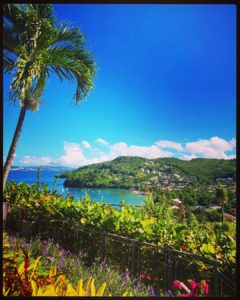
Other useful information
To make the most of your stay, I would recommend renting a car and driving all around the island. Road signs tend to be easy to miss, as they are usually located right before or even after the junctions.
Further reading
To better prepare for my trip, I used the Lonely Planet Caribbean Islands Travel Guide
For original recipes from Martinique and Guadeloupe, I would recommend Vanessa Bolosier’s book Creole Kitchen: Sunshine Flavors from the Caribbean
For my Caribbean-inspired cake recipes, check out my next post published on the 24th of November 2018.
If you’d rather go on island holidays in Europe, check out my 2-week itinerary in the Cyclades, as well as my tips on various Greek islands.
To follow my travels around the world, simply subscribe to the Traveling Psychiatrist (just click on the menu on the left hand side).
Bon voyage!
Alex
(the Traveling Psychiatrist)
One Comment
Pingback: